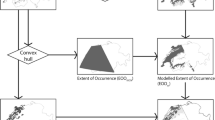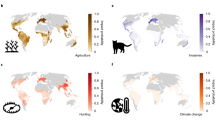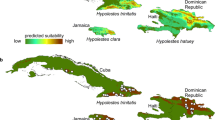Abstract
To assess the conservation status of the Balkans earthworm species from genus Helodrilus and to establish priorities for conservation, we propose an objective and sensitive separate analysis based on the Conservation Priority Index (CPI). Validity of the threatened species in our ranking system was tested by comparing the results with the IUCN (2001) Red List Categories and Criteria: version 3.1. IUCN Species Survival Commission. IUCN, Gland Switzerland and Cambridge, UK. Species were ranked according to their CPI taking into consideration a set of 9 variables (distribution, endemicity, vegetation zones, persistence, density rarity, rarity of occupancy, locality concentration, habitat specificity and habitat rarity). Each of variables was categorized into five ranks (0–4) of increasing risk for survival. The overall score (CPI index) for each species was the sum of all scores for each variable. The index can take values ranging from 0 to 36. We classified threatened species (CPI≥17) in three IUCN (2001) categories. Vulnerable, Endangered and Critically Endangered. All species that had proved to be the VU, EN or CR category according to IUCN (2001) also had a CPI value high enough to be included in some of the categories discussed above (CPI≥17). Our expertise shows that the species which need urgent action are: H. mozsaryorum (CR or EX), H kratochvili (CR), H. deficiens (EN) and H. balcanicus plavensis (EN). H. dinaricus, H. ospensis, H. serbicus, H. jadronensis, H. duhlinskae, H. vagneri, H. slovenicus and H. italicus were known only from the type locality, so we included these species only in suspect CR.
Similar content being viewed by others
References
Abellan P., Fernandez D., Velasco J. and Millan A. (2005). Assessing conservation priorities for insects: status of water beetles in southeast Spain. Biol. Conserv. 121: 79–90
Andreone F. and Luiselli L. (2000). The Italian batrahofauna and its conservation status: a statistical assessment. Biol. Conserv. 96: 197–208
Berg A. and Tjernberg M. (1996). Common and rare Swedish vertebrates, distribution and habitat preference. Biodivers. Conserv. 5: 101–128
Bostrom U. and Holmin A. (1986). Growth of earthworms (Allolobophora caliginosa) fed shoots and roots of barley, meadow fescue and lucern. Studion in relation to particle sizeprotein, crude fiber content and toxicity. Pedobiologia 29: 1–12
Bouche M.B. (1972). Lombriciens de France. Institut National de la Recherche Agronomique, Articles de Zoologie-Ecologie animale, Paris, France, 671 pp.
Burgman A., Ferson A. and Akcakaya R. (1993). Risk Assessment in Conservation Biology. Chapman and Hall, London, UK
Černosvitov L. (1931). Zur Kenntnis der Oligochätenfauna des Balkans III Oligochaeten aus Montenegro und Sudserbien. Zool. Anz. 95: 312–327
Černosvitov L. (1937). Notes sur les Oligochaetes cavernicoles. Mem. Soc. Zool. Tschecosl 5: 125–133
Černosvitov L. (1938). Zur Kenntnis der Oligochätenfauna des Balkans. V. Oligochäten aus Jugoslawien und Albanien. Zool. Anz. 122: 285–289
Clements O., Murray J. and Sturdy G. (1991). The impact of 20 years absence of earthworms and three levels of N fertilizer on a grass land soil environment. Agric. Ecosyst. Environ. 36: 75–85
Cofre H. and Marquet A. (1998). Conservation status, rarity and geographic priorities for conservation of Chilean mammals: an assessment. Biol. Conserv. 88: 1–16
Cognetti M. (1914). Escursion Zoologiche del Dr. E. Festa nell Isolla di rodi V. Oligocheti. Bolletino di ZoologiaTorino 28: 1–6
Cognetti M. (1927). Lombricidi dei Carpazi. Boll. Zool. 7: 1–8
Csuzdi Cs. and Pavliček T. (2005a). Earthworms from Israel. II. Remarks on the genus Perelia Easton, 1983 with descriptions of a new genus and two new species. Acta Zool. Acad. Sci. Hung. 51(2): 75–96
Csuzdi Cs. and Pavliček T. (2005b). The earthworms (Oligochaeta) of Jordan. Zoology in Middle East 34: 71–78
Csuzdi Cs. and Zicsi A. (2003). Earthworms of Hungary. Pedozoologica Hungarica No. 1. Hungary Natural History Museum and Hungary Academy of Sciences, Budapest, Hungary
Easton E.G. (1983). A guide to the valid names of Lumbricidae (Oligochaeta). In: Satchell, J.E. (eds) Earthworm Ecology from Darwin to Vermiculture, pp 475–485. Chapman and Hall, London, UK
Filippi E. and Luiselli L. (2000). Status of the Italian snake fauna and assessment of conservation threats. Biol. Conserv. 93: 219–225
Gates G.E. (1966). Requiem for Megadrile Utopias. A Contribution toward the Understanding of the Earthworm Fauna of North America. Proc. Biol. Soc. Wash. 79: 239–254
Gates G.E. (1976). More on earthworm distribution in North America. Proc. Biol. Soc. Wash. 89: 467–476
Hoffmeister W. (1845). Übersicht aller bis jetzt bekannten Arten aus der Familie der Regenwürmer. Friedrich Vieweg and Sohn, Braunschweig
Horvat I., Glavač V. and Ellenberg H. (1974). Vegetation Sudosteuropas. Gustav Fisher Verlag, Stuttgart
IUCN. (2001). IUCN Red List Categories and Criteria: version. 3.1 IUCN Species Survival Commission. IUCN, Gland, Switzerland and Cambridge, UK
Karaman S. (1969). Ein Beitrag zur Kentnis der Lumbricidenfauna Mazedonians. Zoologischer Anzeiger 182: 75–83
Karaman S. (1972). Beitrag zur Kentnis der Oligochaeten fauna Jugoslawiens. Biološki Vestnik Ljubljana 20: 95–105
Karaman S. (1973). Drugi prilog poznavanju kišnih glista Srbije. Zbornik radova PMF, Priština 1: 177–182
Karaman S. and Stojanović M. (1996a). New earthworm (Oligochaeta and Lumbricidae) records from Serbia (Yugoslavia). Bios 4: 7–13
Karaman S. and Stojanović M. (1996b). Diverzitet faune kišnih glista Jugoslavije sa posebnim pregledom vrsta od međunarodnog značaja. Biodiverzitet Jugoslavije 1: 285–291
Karaman S. and Stojanović M. (2002). Treći prilog poznavanja kišnih glista (Oligochaeta, Lumbricidae) južne i jugoistočne Srbije. Proceeding of 7th. Symposium on Flora of Southeastern Serbia, Dimitrovgrad, Serbia, 223–225
Kostecka J. (1997). Ecology of Allolobophora cernosvitoviana, a species new for the Polish earthworm fauna. Soil Biol. Biochem. 29: 259–263
Kostecka J. and Skoczen S. (1993). Earthworm populations in four types of beech wood Fagetumcarpaticum in the Bieszczady (southeastern Poland). Acta Zoologica Cracoviensia 36: 1–13
Kvavadze E.S. (1985). The Earthworms (Lumbricidae) of the Caucasus. Metsniereba, Tbilisi
Lee K.E. (1985). Earthworms, Their Ecology and Relationships with Soils and Land Use. Academic Press, Sydney, London
Lopatin I. and Matvejev S. (1995). Kratka zoogeografija bioma Balkanskog poluostrva. Matvejev Sergej, Ljubljana
Matvejev S. (1960). Biogeografska karta Jugoslavije. Enciklopedija Jugoslavije 6. Leksikografski zavod FNRJ, Zagreb, Jugoslavija
Matvejev S. and Puncer I. (1989). Landscapes of Yugoslavia. Natural History Museum, Belgrade, Yugoslavia
Michaelsen W. (1902a). Neue Oligochaeten und neue Fundorte alt-bekannter. Mitteilungen aus dem Naturhistorischen Museum in Hamburg 19: 3–53
Michaelsen W. (1902b). Der Einfluss der Eiszeit auf die Verbreitung der Regenwürmer. Verhandlungen des Naturwissentschaftlichen Vereins Hamburg 1: 1–3
Michaelsen W. (1909). Oligochaeta. Die Süsswasserfauna Deutschlands 13: 1–66
Michaelsen W. (1928). Oligochaeten. Handbuch der Zoologie 2: 1–118
Mršić N. (1987). Biolški Vestnik 35: 67–77
Mršić N. (1991). Monograph on Earthworms (Lumbricidae) of the Balkans I-II. Slovenska Akademija Znanosti in Umetnosti, Ljubljana, Jugoslavija
Mršić N. and Šapkarev J. (1987). Survey of the earthworms (Lumbricidae) of Serbia in a restricted sense and description of new taxa. Biološki vestnik 35: 67–86
Mršić N. and Šapkarev J. (1988). Acta Musei Macedonici Scientiarum Naturalium 19: 1–38
Omodeo P. (1952). Particolarita della Zoogeografia dei lombrichi. Boll. Zool. 719: 349–369
Omodeo P. (1953). Nota su alcuni lombrichi delle Alpi e considerationi sul. gen. Helodrilus di Hoffmeister. Memorie del Museo Civico di Storia Naturale di Verona 4: 75–85
Omodeo P. (1956). Contributo alla revisione dei Lumbricidae. Archivio Zoologico Italiano 41: 129–212
Omodeo P. (2000). Evolution and biogeography of megadriles (Annelida and Clitellata). Ital. J. Zool. 67: 179–201
Omodeo P. and Rota E. (1989). Earthworms of Turkey. Boll. Zool. 56: 167–199
Omodeo P. and Rota E. (1991). Earthworms of Turkey II. Boll. Zool. 58: 171–181
Omodeo P. and Rota E. (1999). Biogeographical patterns of terricolous oligochaetes in Turkey (Annelida: Clitellata: LumbricidaeEnchytraeidae). Biogeografia 20: 62–79
Perel T.S. (1964). Rasprostranenie doždovych červej (Lumbricidae) v ravninych lesach evropejskoj časti SSSR. Pedobiologia 4: 92–110
Perel T.S. (1976). A critical analysis of the Lumbricidae genera system (with key to the USSR fauna genera). Révue d’Écologie et Biologie du Sol 13: 635–643
Perel S. (1979). Range and Regularities in the distribution of earthworms of the USSR fauna. USSR, Nauka Moskow, Moskow
Pop V. (1949). Lumbricidele din România. Analele Academiei Republicii Populare Române 1: 383–505
Rabinowitz D. (1981). Seven forms of rarity. In: Synge, H. (eds) The Biological Aspects of Rare Plant Conservation, pp 205–217. Wiley, New York
Rosa D. (1893a). Revisione dei lumbricidi. Memoire della Reale Academia delle Scienze di Torino 43: 399–477
Rosa D. (1893b). Viaggio del Dr. E. Festa in Palestinanel Libano e regioni vicine II. Lumbricidi. Bollettino dei Musei di Zoologia ed Anatomia comparata della R. Universitá di Torino 8: 1–14
Rozen A. (1988). The annual cycle in populations of earthworms (Lumbricidae) in 3 types oak hornbeam of the Niepolomicka Forest. 2. Dynamics of populations numbers, biomass and age structure. Pedobiologia 31: 169–178
Stojanović M. (1989). Uticaj antropogenog faktora na dinamiku razvoja lumbricidnog naselja u okolini Kragujevca. Faculty of Science, Kragujevac, Jugoslavija
Stojanović M. 1996. Faunističko-ekološka studija Lumbricida (Oligochaeta) Srbije. Ph.D. thesis. Faculty of Science, Kragujevac, Jugoslavija
Stojanović M. and Karaman S. (2002).. DimitrovgradSrbija. Proceeding of the 7th. Symposium on Flora of Southeastern Serbia, Dimitrovgrad, Serbia, 227–228
Stojanović M. and Karaman S. (2003a). Contribution to the knowledge of the earthworms of Serbia. Lumbricids of Šumadija. Abstract book of the II Congress of Ecologist of Macedonia, Ohrid, 175–176
Stojanović M. and Karaman S. (2003b). Abstract book of the II Congress of Ecologist of Macedonia, Ohrid, 176
Stojanović M. and Karaman S. (2004a). Contribution to the knowledge of the Earthworms of Serbia. Lumbricids of Šumadija. Proceedings of the II Congress of Ecologist of Macedonia, Ohrid, 497–500
Stojanović M. and Karaman S. (2004b).. Proceedings of the II Congress of Ecologist of Macedonia, Ohrid, 500–501
Stojanović M. and Karaman S. (2005a). Second contribution to the knowledge of the earthworms of Šumadija. Archives of Biological Sciences 57: 127–133
Stojanović M. and Karaman S. (2005b). Distribution on the Balkans and neighboring territory of two species for the earthworm fauna of Šumadija. Archives of Biological Sciences 57: 133–137
Šapkarev J. (1971). Neue Regenwürmer (Oligochaeta: Lumbricidae) aus Mazedonien. Fragmenta Balcanica Skopje 8: 149–164
Šapkarev J. (1972). The fauna of earthworms of Macedonia. The earthworms of the valley of Pelagonia. Fragmenta Balcanica Skopje 9: 125–135
Šapkarev J. (1975). Contribution to the knowledge the earthworms (Lumbricidae) and leeches (Hirudinea) of KosovoYugoslavia. Annuaire de la Faculté des Sciences de l’Université de Skopje 27: 39–54
Šapkarev J. (1978). Kišne gliste Jugoslavije. Sadašnja taksonomska proučenost i njihova dalja istraživanja. Biosistematika 4: 293–304
Šapkarev J. (1979). Lumbricidna fauna na Makedonija. Doždovni glisti (OligochaetaLumbricidae) od Ovčepolska kotlina. Godišen zbornik 32: 5–16
Šapkarev J. (1980). Prilog poznavanja kišnih glisti SR Srbije. Zbornik Radova faune Srbije 1: 165–179
Šapkarev J. (1986). Description of new species of earthworms (Oligochaeta: Lumbricidae) from Yugoslavia. Macedonian Academy of Sciences 7: 33–46
Šapkarev J. 2002. Rasprostranjenje kišnih glista središnje Srbije. Zbornik radova SANU, pp. 307–318.
Zics A. (1967). Beitrage zur Kenntnis der Ungarichen Lumbriciden Fauna. V. Acta Zool. Hung. 13: 245–252
Zicsi A. (1985). Uber die gattungen Helodrilus Hoffmeister 1845 und Proctodrilus genn. (Oligochaeta and Lumbricidae). Acta Zool. Hung. 31: 275–289
Zicsi A. (1968). Ein zusammenfassendes Verbreitungsbild der Regenwürmer auf Grund der Boden- und Vegetations verhältnisse Ungarns. Opuscula Zoologica Budapest 8: 99–164
Zicsi A. (1974). Ein neuer Höhlen-Regenwurm (Oligochaeta: Lumbricidae) aus Ungarn. Acta Zool. Hung. 20: 227–232
Zicsi A. (1975). Zootische Einflüsse auf die Streuzersetzung in Hainbuchen-Eichenwäldern Ungarns. Pedobiologia 15: 432–438
Zicsi A. (1982). Verzeichniss der bis 1971 beschribenen und revidierten Taxa der Familie Lumbricidae (Oligochaeta). Acta Zool. Hung. 28: 421–454
Zicsi A. and Michalis K. (1981). Ubersicht der Regenwurmer Fauna Griechenlands (Oligochaeta and Lumbricidae). Acta Zool. Hung. 27: 239–264
Zicsi A. and Csuzdi Cs. (1986). Regenwürmer aus Bulgarien (Oligochaeta: Lumbricidae). Opuscula Zoologica Budapest 22: 113–121
Zicsi A. and Csuzdi Cs. (1999). Weitere Angaben zur Regenwurmfauna Frankreichs mit Beschreibung fünf neuer Arten (Oligochaeta: Lumbricidae). Rev. Suisse Zool. 106: 983–1003
Zicsi A., Dózsa-Farkas K. and Csuzdi Cs. 1999. Terrestrial Oligochaetes of the Aggtelek National Park. In: Mahunka S. (eds), The Fauna of the Aggtelek National Park. Hungarian Natural History Museum Budapest, pp. 39–43.
Author information
Authors and Affiliations
Corresponding author
Rights and permissions
About this article
Cite this article
Stojanović, M., Karaman, S. Threat Status and Distribution of the Earthworm Genus Helodrilus Hoffmeister, 1845; Sensu Zicsi 1985, on the Balkans and the Neighboring Regions. Biodivers Conserv 15, 4601–4617 (2006). https://doi.org/10.1007/s10531-005-5823-9
Received:
Accepted:
Published:
Issue Date:
DOI: https://doi.org/10.1007/s10531-005-5823-9




